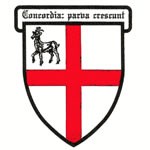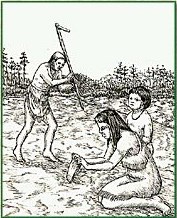
Corn (maize), the Algonquian name of which Thomas Harriot recorded as pagatowr, was a staple found in one form or another in many Indian dishes and at most Indian meals. The bounty and versatility of Indian corn impressed Harriot, who spent nearly a year in the region with the Ralph Lane colony and described the ubiquitous cereal at length in his Briefe and True Report of the New Found Land of Virginia (1588): 
Vicki Wallace The graine is about the bignesse of our ordinary English peaze and not much different in forme and shape: but in divers colours: some white, some red, some yellow, and some blew. All of them yeelded a very white and sweet flowre: being used according to his kinde it maketh a very good bread. Wee made of the same in the countrey some mault, wherof was bruwed as good Ale as was to bee desired. So likewise by the helpe of hops therof may bee made as good Beere. It is a graine of marveillous great increase; of a thousand, fifteened hundred and some two thousand fold. There are three sortes, of which two are ripe in eleven and twelve veekes at the most: sometimes in ten, after the time they are set, and are then of height in stalke about sixe of seven foote. The other sort is ripe in foureteene, and is about ten foote high...Of these graines besides bread, the inhabitants make victuall, eyther by parching them, or seething them whole untill they be broken; or boyling the floure with water into a pappe. Besides the manifold waies in applying it to victuall, the increase is somuch that small labour and paines in needful...according to the rate we have made proofe of, one man may prepare and husband so much grounde...with lesse then foure and twentie houres labour, as shall yeeld him victuall in a large proportion for a twelvemoneth...[the Indians] sowe or set...anie time when they thinke good from the middest of March untill the end of Iune...In some places of the countrey notwithstanding they have tow harvests, as we have heard, out of one and the same ground. Harriot distinguished okindgfer, probably kidney beans, from the smaller wickonzowr, "called by vs Peaze," for which he expressed a strong preference. The Indians may have grown other pulses that Harriot was unable to distinguish. According to Harriot, the Algonquians used a single term, macocqwer, for "Pompoins, Mellions, and Gourdes." Pumpkins, raw and cooked, were an important part of the Indian diet. There were no melons on the continent in the sixteenth century; those that Harriot and others described were varieties of pumpkin and squash. On his 1584 reconnaissance, Arthur Barlowe undoubtedly mistook some kind of squash for cucumbers. (The Spanish had introduced cucumbers at St. Augustine only nineteen years before, so it is doubtful that the species had worked its way up the coast to North Carolina by the time of Barlowe's visit.) Harriot implies that the Indians ate gourds, but they seem to have used them mainly for rattles, ladles, and storage vessels. Sunflowers " about sixe foot in height " provided seeds for " both a kinde of bread and broth. " " An hearbe which in Dutch is called Melden" provided the Indians seeds for " a thicke broth, and pottage of a very good taste, " and ashes of the stalk made a salt substitute. (This was probably the saltbush, genus Atriplex, not as the Dutch name indicates a relative of spinach.) Uppowoc or tobacco, served a number of religious and ceremonial purposes. Harriot wrote, This Uppowoc is of so precious estimation amongest them, that they thinke their gods are marvelously delighted therwith...sometime they make hallowed fires & cast some of the pouder therein for a sacrifice: being in a storme uppon the waters, to pacifie their gods, they cast some u into the aire and into the water: so a weare for fish being newly set up, they cast some therein and into the aire: also after an escape of danger, they cast some into the aire likewise. Tobacco smoke also played a prominent role in Indian medicine, and colonists quickly adopted it as a tonic, preventive, and cure-all. Harriot reported that he had "found manie rare and wonderfull experiments of vertues thereof; of which the relation woulde require a volume by it selfe. " The tobacco that the Indians grew seems not to have been Nicotiana tabacum, now grown and sold virtually worldwide, but the hardier, faster-growing, much stronger, and potentially intoxicating N. rustica. Harriot reported, and John White's drawings show, that the Indians grew tobacco in plots dedicated solely to its culture. The other crops, however, were set or sowed, sometimes in groundes apart and severally by themselves, but for the most part together in one ground mixtly. Unlike their brethren farther north, the Algonquians of eastern North Carolina took few pains to increase the fertility of the soil: The ground they neuer fatten with mucke, dounge, or any other thing, neither plow nor digge it as we in England...A few daies before they sowe of set, the men with wooden instruments, made almost in forme of mattockes of hoes with long handles; the women with short peckers or parers, because they vse them sitting, of a foote long and about fiue inches in breadth: doe onely breake the vpper part of the ground to rayse vp the weedes, grasse, & olde stubbes of corne stalks with their rootes. The which after a day or twoes drying in the Sunne, being scrapte vp into many small heapes, to saue them labour for carrying them away; they burne into ashes. (And whereas some may thinke that they vse the ashes for to better the ground, I say that then they would either disperse the ashes abroade, which wee observed they do not...or else would take speciall care to set their corne where the ashes lie, which also wee finde they are carelesse of.) And this is all the husbanding of their ground that they vse. Although Harriot chided the Indians for their apparent lack of industry, he conceded in several passages that the soil was so fertile it needed little attention: " ...an English Acre...doeth there yeeld in croppe or ofcome of corne, beanes, and peaze, at the least two hundred London bushelles, besides the Macocqwer, Melden and Planta solis [sunflower]..." Actual yields were much lower, perhaps as little as one-tenth of Harriot's estimate. When the Indians had prepared the ground to their satisfaction, they sowed it, not in rows, but in mounds arranged in ranks and files: First for their corne, beginning in one corner of the plot, with a pecker they make a hole wherein they put foure graines, with that care they touch not one another (about an inch asunder) and couer them with the moulde againe: and so through out the whole plot...there is a yard spare ground betwene euery hole: where according to discretion here and there, they set as many Beanes and Peaze; in diuers places also among the seedes of Macocqwer, Melden, and Planta solis. No surviving account of the Roanoke colonies says much about the division of labor among the local Indians. In Virginia, Algonquian men occupied themselves with hunting, fishing, and fighting and left agriculture to women, children, the elderly, and slaves. The Algonquians of North Carolina probably did likewise. In large settlements the Indians evidently took turns frightening animals away from the ripening crops. As Harriot noted "...they builde as yt weare a scaffolde wher of they sett a cottage like a rownde chaire...wherein they place one to watche, for there are suche nomber of fowles, and beasts, that vnless they keepe the better watche, they would soone deuoure all ther corne." The Indians practiced little economic specialization. Any family of sufficient size could live comfortably on the fruits of its own labor. Town dwellers seem to have cooperated in clearing land, planting crops, and driving off pests and perhaps in fishing and hunting; they may also have shared food-storage buildings. The tribute demanded by rulers and conquerors was often great, even by the standards of the modern welfare state; so commoners sometimes suffered want in the midst of great natural plenty. As John Lawson and other later observers attested, Indians often pooled resources in order to take care of the needy in their own immediate groups. Even so, agricultural land was privately held, and the Indians of the region seem to have shown scrupulous respect for ownership, as Lawson reported, They have no Fence to part one anothers Lots in their Corn-Fields; but every Man knows his own, and it scarce ever happens, that they rob one another of so much as an Ear of Corn, which if any is found to do, he is sentenced by the Elders to work and plant for him that was robb's, till he is recompensed for all the Damage he has suffer'd in his Corn-Field; and this is punctually perform'd, and the Theif held in Disgrace, that steals from any of his Country-Folks. The agriculture that the Indians of eastern North Carolina practiced was not very sophisticated. It offered little variety-a few pulses and seeds, one grain, one seasoning, no pot herbs, no salad herbs, no domesticated animals. It was not very efficient. It depleted the soil and made necessary the continual relocation of farmsteads and towns and almost-constant clearing and breaking of new ground. But for countless centuries it helped the vigorously active indigenous peoples eke out their less-reliable sources of nutrition. Indian agriculture was even able to provide surpluses for the improvident Roanoke colonists to live on as they tramped the region in search of precious metals and merchantable commodities. Text based on "Indian Agriculture In Coastal North Carolina 400 Years Ago" by David Stick; edited and expanded by lebame houston and Wynne Dough Illustrations: Vicki Wallace |
Last updated: April 14, 2015
